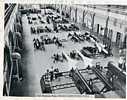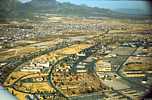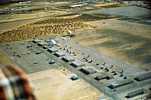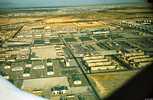- Redstone Arsenal (Huntsville Alabama) training for Ordnance people - a higher echelon of repair
- Ft. Bliss (El Paso, Texas), training for the people at the individual Nike sites.
- Initial Nike training - Enlisted
- Initial Nike training - Officers
-
-
-
- Play - 1954 era
Redstone Arsenal (Huntsville Alabama) training for Ordnance people - a higher echelon of repair
|
Ft. Bliss (El Paso, Texas), training for the people at the individual Nike sites.
U.S. Army and U.S. allied personnel received formal Nike training at Ft. Bliss
|
Ft. Bliss, practically in El Paso, Texas, was the primary formal training site
for anti-aircraft guns and missiles for the U.S. Army for about a century.
(The function was moved in about 2005 to Ft. Sill - somewhere ;-)
From Gordon Lunn
Ft. Bliss (northeast of El Paso) and the three nearby missile ranges
I didn't have a camera in the army. Fortunately Jos Weijenberg
took lots of pictures, and kindly shares them here.
Ft. Bliss Foreign Student Handout Handout .pdf 8 Megabytes from A.J.M. (Jos) Weijenberg |
Initial Nike training - Enlisted
Most of the operating people got their initial Nike training at Fort Bliss, (El Paso) Texas. I was assigned to class SAM-23 in the spring of 1954, and learned and trained on Nike Ajax fire control equipment (radars, computer) for a year at and near Ft. Bliss, Texas. Our class had about 35 people in it. We were of two major groups:
We privates got to "pull KP" - which meant getting roused extra early and missing a day of school. Later I could go through the schematics and point out the pages which had been discussed while I was on KP. :-(( We heard that the Air Force had a more enlightened attitude about students missing school for KP. :-(( There was an optional night school where people from many classes could get extra help from the knowledgeable staff. People who were slow (poor in tests) in school were obligated to attend night school to review and catch up. I got to spend a week in "dumb-dumb" night school after a sharp disagreement with an instructor about how to align a radio transmitter. I am not now sure who was correct, but I lost sufficient points in that weekly quiz to force my attendance at night school for a week. One of the sergeants spent most of his year's training also attending night "dumb-dumb" school. Oddly enough, folks said that he was just fine on his Nike site later - the guy just had little scholastic aptitude. While at this school, in 1955, I sent the following to my sister.
After training, the operating people were divided into battalion or battery sized "packages" (commanding officers got to interview and help select their future soldiers). From this distance in time (45 years later) I feel sorry for my battery commander. He had already selected two good IFC maintenance candidates (previous classes, and who had done light instructional duties about Ft. Bliss) and had to pick one more. I am sure that I, as an opinionated, argumentative, wild haired new graduate, was not his first round draft choice. A classmate went into a different "package". This is his story. The IFC personnel from each battery then practiced on actual Nike systems in "Radar Park" in Ft. Bliss for a few weeks. The instructors inserted many faults (bad tubes, open interlocks, defective cables, mis-adjusted adjustments, ... . It was really fun to put all that book learning to work! Then each battery went to:
Our "package" was then sent to our new battery site in Chicago ( with, if I remember correctly, about two weeks travel time to allow travel to and visiting in home towns).
The IFC technical people (warrant officers and enlisted) got about a year of training. This was divided into:
We (IFC technical people) went over every page of the schematics carefully, and had lots of trouble shooting and adjustment practice. I felt (in 1955) quite satisfied - except:
At the conclusion of formal training, we were interviewed by battery commanders who were forming up people to install and operate new sites. There was an attempt to match people's desires of location with Army needs. Chicago was the closest available at the time to my home (Minnesota) and I requested that city. Captain Hill was going to Chicago, and (after he interviewed me) I was admitted to his "team" along with 2 other IFC mechanics and maybe 40 other people who had received training in various aspects of Nike operations. We started to work on the equipment for about 2 weeks as a unit. After that we moved about 100 miles away to Red Canyon Missile range to fix/adjust their local radars (previously un-fixed and mis-adjusted to give us plenty of exercise) and fire a missile to shoot down a target called an RCAT. While there, a week to 10 days??, we lived in Red Canyon Range Camp, a tent village. The sheet metal mess hall was the most substantial building. After a short leave, we gathered at the Chicago site which was in Jackson Park - 63rd South and Outer Drive. It was called "C-41". The buildings, launcher pits, roads, fences, radar pads, etc. were all ready for the new equipment which arrived in a few days. We installed and cabled up the new equipment and made it operational (in two weeks?). Then more people arrived to receive "on the job" training and fill the manning slots. And we were "ready". Ron Loving said that later (1964) there were 4 week courses in Electronic Counter Measures. "The classes tried to teach you that what you saw on the scope could be countered by putting in standard "fixes" against the type of jamming represented on the scope. In reality, one could try individual "fixes" or mix and match the "fixes" until the scope cleared up or you went to "Track On Jam" (TOJ). I was never satisfied with the "School Solution" for jamming because it was not that close to reality." The Launcher technical people got (???). The operators got (? 2 weeks?). Did not seem much. |
Initial Nike training - Officers
In 1964, (Information courtesy Ron Loving)
New (Sept 2009) is Captain Philip Oswald commanding 1959-1962
Ron Loving commanded both Nike and Hawk batteries. In response to the question "I am presuming the technical and fire decision challenges facing a Hawk officer are quite different from those facing a Nike officer???" Ron responded with "Officers in the two missile batteries faced the same challenges. That being the continual training of the crews, supplies (Logistics) and other daily operational procedures from motor pool inspection to care and feeding of the troops. The differences being in the operational procedures for the different batteries. During officer basic and advanced courses at Ft. Bliss all officers were trained the same. It was after they arrived at their new assignment that the missile specific training started. Both types of missiles were controlled the same way by the Air Force through the ADCAP early warning systems." Aug 2020, Kurt Keller wrote:
Gordon Lunn responded:
|
And of course, folks want to - play :-)) - My version in the 1954 era -
Updated through Oct 5, 2013





